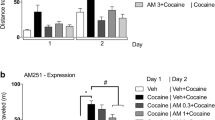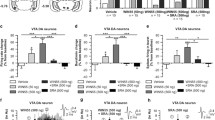Abstract
Cannabinoids and the endocannabinoid system are implicated in the regulation of various physiological processes, including motivational and reward-related behavior as well as affective and motoric responses. Although the literature is vast, methodological variations in studies can sometimes hinder our understanding of these regulatory effects.
In particular, the impact of cannabinoids on motor activity has to be focused on a variety of factors including drug dose, experimental setting (habituated versus non-habituated animals), and rat phenotype. In addition, the parallel study of the cannabinoid-induced effects on neurochemical correlates such as dopaminergic and glutamatergic indices adds essentially to the understanding of the implication of cannabinoids on physiological procedures. The use of both ex vivo tissue extraction and in vivo microdialysis methods allow for a more robust, comparison-based approach to the study of the cannabinoid-induced neurochemical profile.
In general, our behavioral studies have shown that high doses of cannabinoids impair the expression of novelty-induced behavior, while low doses disrupt behavioral habituation resulting in increases in motor and exploratory activity. Our neurochemical findings have shown that cannabinoid treatment exerts excitatory effects on dopaminergic function, but both excitatory and inhibitory effects on glutamate neurotransmission that are more robust at higher doses. The overactivation, suppression, or dysregulation of these specific neurotransmitters in basal ganglia or corticolimbic structures have been associated with basal ganglia disorders, drug addiction, and related psychoses. Thus, the behavioral and neurochemical effects of cannabinoids in these distinct brain regions are of great importance for furthering our understanding of specific CNS disorders and their pathophysiology, as well as for approaching new therapeutic strategies.
Access this chapter
Tax calculation will be finalised at checkout
Purchases are for personal use only
Similar content being viewed by others
References
Higuera-Matas A, Ucha M, Ambrosio E (2015) Long-term consequences of perinatal and adolescent cannabinoid exposure on neural and psychological processes. Neurosci Biobehav Rev 55:119–146. doi:10.1016/j.neubiorev.2015.04.020
Hurd YL, Michaelides M, Miller ML, Jutras-Aswad D (2014) Trajectory of adolescent cannabis use on addiction vulnerability. Neuropharmacology 76(Pt B):416–424. doi:10.1016/j.neuropharm.2013.07.028
Moore TH, Zammit S, Lingford-Hughes A, Barnes TR, Jones PB, Burke M, Lewis G (2007) Cannabis use and risk of psychotic or affective mental health outcomes: a systematic review. Lancet 370:319–328. doi:10.1016/S0140-6736(07)61162-3
Rubino T, Parolaro D (2014) Cannabis abuse in adolescence and the risk of psychosis: a brief review of the preclinical evidence. Prog Neuropsychopharmacol Biol Psychiatry 52:41–44. doi:10.1016/j.pnpbp.2013.07.020
Schneider M (2008) Puberty as a highly vulnerable developmental period for the consequences of cannabis exposure. Addict Biol 13:253–263. doi:10.1111/j.1369-1600.2008.00110.x
Galanopoulos A, Polissidis A, Georgiadou G, Papadopoulou-Daifoti Z, Nomikos GG, Pitsikas N, Antoniou K (2014) WIN55,212-2 impairs non-associative recognition and spatial memory in rats via CB1 receptor stimulation. Pharmacol Biochem Behav 124:58–66. doi:10.1016/j.pbb.2014.05.014
Polissidis A, Chouliara O, Galanopoulos A, Naxakis G, Papahatjis D, Papadopoulou-Daifoti Z, Antoniou K (2014) Cannabinoids negatively modulate striatal glutamate and dopamine release and behavioural output of acute D-amphetamine. Behav Brain Res 270:261–269. doi:10.1016/j.bbr.2014.05.029
Galanopoulos A, Polissidis A, Papadopoulou-Daifoti Z, Nomikos GG, Antoniou K (2011) Delta(9)-THC and WIN55,212-2 affect brain tissue levels of excitatory amino acids in a phenotype-, compound-, dose-, and region-specific manner. Behav Brain Res 224:65–72. doi:10.1016/j.bbr.2011.05.018
Polissidis A, Galanopoulos A, Naxakis G, Papahatjis D, Papadopoulou-Daifoti Z, Antoniou K (2013) The cannabinoid CB1 receptor biphasically modulates motor activity and regulates dopamine and glutamate release region dependently. Int J Neuropsychopharmacol 16:393–403. doi:10.1017/S1461145712000156
Akirav I (2011) The role of cannabinoids in modulating emotional and non-emotional memory processes in the hippocampus. Front Behav Neurosci 5:34. doi:10.3389/fnbeh.2011.00034
Polissidis A, Chouliara O, Galanopoulos A, Rentesi G, Dosi M, Hyphantis T, Marselos M, Papadopoulou-Daifoti Z, Nomikos GG, Spyraki C, Tzavara ET, Antoniou K (2010) Individual differences in the effects of cannabinoids on motor activity, dopaminergic activity and DARPP-32 phosphorylation in distinct regions of the brain. Int J Neuropsychopharmacol 13:1175–1191. doi:10.1017/S1461145709991003
Hashimotodani Y, Ohno-Shosaku T, Kano M (2007) Endocannabinoids and synaptic function in the CNS. Neuroscientist 13:127–137. doi:10.1177/1073858406296716, 13/2/127 [pii]
Muccioli GG (2010) Endocannabinoid biosynthesis and inactivation, from simple to complex. Drug Discov Today 15:474–483. doi:10.1016/j.drudis.2010.03.007
Iversen L (2003) Cannabis and the brain. Brain 126:1252–1270
Panagis G, Vlachou S, Nomikos GG (2008) Behavioral pharmacology of cannabinoids with a focus on preclinical models for studying reinforcing and dependence-producing properties. Curr Drug Abuse Rev 1:350–374
Solinas M, Goldberg SR, Piomelli D (2008) The endocannabinoid system in brain reward processes. Br J Pharmacol 154:369–383. doi:10.1038/bjp.2008.130, bjp2008130 [pii]
Gardner EL (2005) Endocannabinoid signaling system and brain reward: emphasis on dopamine. Pharmacol Biochem Behav 81:263–284. doi:10.1016/j.pbb.2005.01.032, S0091-3057(05)00130-9 [pii]
Darmani NA (2001) The cannabinoid CB1 receptor antagonist SR 141716A reverses the antiemetic and motor depressant actions of WIN 55, 212-2. Eur J Pharmacol 430:49–58, S0014299901013553 [pii]
Giuliani D, Ferrari F, Ottani A (2000) The cannabinoid agonist HU 210 modifies rat behavioural responses to novelty and stress. Pharmacol Res 41:47–53. doi:10.1006/phrs.1999.0560, phrs.1999.0560 [pii]
Jarbe TU, Andrzejewski ME, DiPatrizio NV (2002) Interactions between the CB1 receptor agonist Delta 9-THC and the CB1 receptor antagonist SR-141716 in rats: open-field revisited. Pharmacol Biochem Behav 73:911–919, S0091305702009383 [pii]
Schramm-Sapyta NL, Cha YM, Chaudhry S, Wilson WA, Swartzwelder HS, Kuhn CM (2007) Differential anxiogenic, aversive, and locomotor effects of THC in adolescent and adult rats. Psychopharmacology (Berl) 191:867–877. doi:10.1007/s00213-006-0676-9
Davis WM, Borgen LA (1974) Effects of cannabidiol and delta-9-tetrahydrocannabinol on operant behavior. Res Commun Chem Pathol Pharmacol 9:453–462
Drews E, Schneider M, Koch M (2005) Effects of the cannabinoid receptor agonist WIN 55,212-2 on operant behavior and locomotor activity in rats. Pharmacol Biochem Behav 80:145–150. doi:10.1016/j.pbb.2004.10.023, S0091-3057(04)00350-8 [pii]
Rodvelt KR, Bumgarner DM, Putnam WC, Miller DK (2007) WIN-55,212-2 and SR-141716A alter nicotine-induced changes in locomotor activity, but do not alter nicotine-evoked [3H]dopamine release. Life Sci 80:337–344. doi:10.1016/j.lfs.2006.09.020, S0024-3205(06)00738-7 [pii]
Sulcova E, Mechoulam R, Fride E (1998) Biphasic effects of anandamide. Pharmacol Biochem Behav 59:347–352, S0091-3057(97)00422-X [pii]
Antoniou K, Kafetzopoulos E (1996) The pattern of locomotor activity after cocaine treatment in the rat. Behav Pharmacol 7:237–244
Antoniou K, Kafetzopoulos E, Papadopoulou-Daifoti Z, Hyphantis T, Marselos M (1998) D-amphetamine, cocaine and caffeine: a comparative study of acute effects on locomotor activity and behavioural patterns in rats. Neurosci Biobehav Rev 23:189–196
Antoniou K, Papathanasiou G, Panagis G, Nomikos GG, Hyphantis T, Papadopoulou-Daifoti Z (2004) Individual responses to novelty predict qualitative differences in d-amphetamine-induced open field but not reward-related behaviors in rats. Neuroscience 123:613–623, S0306452203007905 [pii]
Antoniou K, Papathanasiou G, Papalexi E, Hyphantis T, Nomikos GG, Spyraki C, Papadopoulou-Daifoti Z (2008) Individual responses to novelty are associated with differences in behavioral and neurochemical profiles. Behav Brain Res 187:462–472. doi:10.1016/j.bbr.2007.10.010, S0166-4328(07)00544-X [pii]
Polissidis A, Chouliara O, Galanopoulos A, Marselos M, Papadopoulou-Daifoti Z, Antoniou K (2009) Behavioural and dopaminergic alterations induced by a low dose of WIN 55,212-2 in a conditioned place preference procedure. Life Sci 85:248–254. doi:10.1016/j.lfs.2009.05.015
Pawlak CR, Schwarting RK (2002) Object preference and nicotine consumption in rats with high vs. low rearing activity in a novel open field. Pharmacol Biochem Behav 73:679–687
Piazza PV, Deminiere JM, Le Moal M, Simon H (1989) Factors that predict individual vulnerability to amphetamine self-administration. Science 245:1511–1513
Thiel CM, Muller CP, Huston JP, Schwarting RK (1999) High versus low reactivity to a novel environment: behavioural, pharmacological and neurochemical assessments. Neuroscience 93:243–251, S0306-4522(99)00158-X [pii]
Cools AR, Ellenbroek BA, Gingras MA, Engbersen A, Heeren D (1997) Differences in vulnerability and susceptibility to dexamphetamine in Nijmegen high and low responders to novelty: a dose-effect analysis of spatio-temporal programming of behaviour. Psychopharmacology (Berl) 132:181–187
Piazza PV, Deminiere JM, Maccari S, Mormede P, Le Moal M, Simon H (1990) Individual reactivity to novelty predicts probability of amphetamine self-administration. Behav Pharmacol 1:339–345
Pacher P, Batkai S, Kunos G (2006) The endocannabinoid system as an emerging target of pharmacotherapy. Pharmacol Rev 58:389–462. doi:10.1124/pr.58.3.2
Navarro M, Fernandez-Ruiz JJ, de Miguel R, Hernandez ML, Cebeira M, Ramos JA (1993) An acute dose of delta 9-tetrahydrocannabinol affects behavioral and neurochemical indices of mesolimbic dopaminergic activity. Behav Brain Res 57:37–46
Navarro M, Fernandez-Ruiz JJ, De Miguel R, Hernandez ML, Cebeira M, Ramos JA (1993) Motor disturbances induced by an acute dose of delta 9-tetrahydrocannabinol: possible involvement of nigrostriatal dopaminergic alterations. Pharmacol Biochem Behav 45:291–298, 0091-3057(93)90241-K [pii]
Rodriguez De Fonseca F, Fernandez-Ruiz JJ, Murphy LL, Cebeira M, Steger RW, Bartke A, Ramos JA (1992) Acute effects of delta-9-tetrahydrocannabinol on dopaminergic activity in several rat brain areas. Pharmacol Biochem Behav 42:269–275
Chen JP, Paredes W, Li J, Smith D, Lowinson J, Gardner EL (1990) Delta 9-tetrahydrocannabinol produces naloxone-blockable enhancement of presynaptic basal dopamine efflux in nucleus accumbens of conscious, freely-moving rats as measured by intracerebral microdialysis. Psychopharmacology (Berl) 102:156–162
Chen JP, Paredes W, Lowinson JH, Gardner EL (1991) Strain-specific facilitation of dopamine efflux by delta 9-tetrahydrocannabinol in the nucleus accumbens of rat: an in vivo microdialysis study. Neurosci Lett 129:136–180
Malone DT, Taylor DA (1999) Modulation by fluoxetine of striatal dopamine release following Delta9-tetrahydrocannabinol: a microdialysis study in conscious rats. Br J Pharmacol 128:21–26. doi:10.1038/sj.bjp.0702753
Pistis M, Ferraro L, Pira L, Flore G, Tanganelli S, Gessa GL, Devoto P (2002) Delta(9)-tetrahydrocannabinol decreases extracellular GABA and increases extracellular glutamate and dopamine levels in the rat prefrontal cortex: an in vivo microdialysis study. Brain Res 948:155–158, S000689930203055X [pii]
Tanda G, Loddo P, Di Chiara G (1999) Dependence of mesolimbic dopamine transmission on delta9-tetrahydrocannabinol. Eur J Pharmacol 376:23–26, S0014-2999(99)00384-2 [pii]
Drossopoulou G, Antoniou K, Kitraki E, Papathanasiou G, Papalexi E, Dalla C, Papadopoulou-Daifoti Z (2004) Sex differences in behavioral, neurochemical and neuroendocrine effects induced by the forced swim test in rats. Neuroscience 126:849–857. doi:10.1016/j.neuroscience.2004.04.044
Dalla C, Antoniou K, Papadopoulou-Daifoti Z, Balthazart J, Bakker J (2004) Oestrogen-deficient female aromatase knockout (ArKO) mice exhibit depressive-like symptomatology. Eur J Neurosci 20:217–228. doi:10.1111/j.1460-9568.2004.03443.x
Dalla C, Antoniou K, Papadopoulou-Daifoti Z, Balthazart J, Bakker J (2005) Male aromatase-knockout mice exhibit normal levels of activity, anxiety and “depressive-like” symptomatology. Behav Brain Res 163:186–193. doi:10.1016/j.bbr.2005.04.020
Commissiong JW (1985) Monoamine metabolites: their relationship and lack of relationship to monoaminergic neuronal activity. Biochem Pharmacol 34:1127–1131, 0006-2952(85)90484-8 [pii]
Hitzemann R, Curell J, Hom D, Loh H (1982) Effects of naloxone on d-amphetamine- and apomorphine-induced behavior. Neuropharmacology 21:1005–1011
Miura H, Qiao H, Ohta T (2002) Influence of aging and social isolation on changes in brain monoamine turnover and biosynthesis of rats elicited by novelty stress. Synapse 46:116–124. doi:10.1002/syn.10133
Tavares JV, Drevets WC, Sahakian BJ (2003) Cognition in mania and depression. Psychol Med 33:959–967
Cerbone A, Sadile AG (1994) Behavioral habituation to spatial novelty: interference and noninterference studies. Neurosci Biobehav Rev 18:497–518
Tanda G, Pontieri FE, Di Chiara G (1997) Cannabinoid and heroin activation of mesolimbic dopamine transmission by a common mu1 opioid receptor mechanism. Science 276:2048–2050
Diana M, Melis M, Gessa GL (1998) Increase in meso-prefrontal dopaminergic activity after stimulation of CB1 receptors by cannabinoids. Eur J Neurosci 10:2825–2830
Kuepper R, Ceccarini J, Lataster J, van Os J, van Kroonenburgh M, van Gerven JM, Marcelis M, Van Laere K, Henquet C (2013) Delta-9-tetrahydrocannabinol-induced dopamine release as a function of psychosis risk: 18F-fallypride positron emission tomography study. PLoS One 8:e70378. doi:10.1371/journal.pone.0070378
Acknowledgements
This research project was co-financed by EU-European Social Fund (75 %) and the Greek Secretariat of Research and Technology—GSRT (25 %) (PENED, O3ED768).
Author information
Authors and Affiliations
Corresponding author
Editor information
Editors and Affiliations
Rights and permissions
Copyright information
© 2017 Springer Science+Business Media New York
About this protocol
Cite this protocol
Antoniou, K., Polissidis, A., Delis, F., Poulia, N. (2017). The Impact of Cannabinoids on Motor Activity and Neurochemical Correlates. In: Philippu, A. (eds) In Vivo Neuropharmacology and Neurophysiology. Neuromethods, vol 121. Humana Press, New York, NY. https://doi.org/10.1007/978-1-4939-6490-1_15
Download citation
DOI: https://doi.org/10.1007/978-1-4939-6490-1_15
Published:
Publisher Name: Humana Press, New York, NY
Print ISBN: 978-1-4939-6488-8
Online ISBN: 978-1-4939-6490-1
eBook Packages: Springer Protocols




